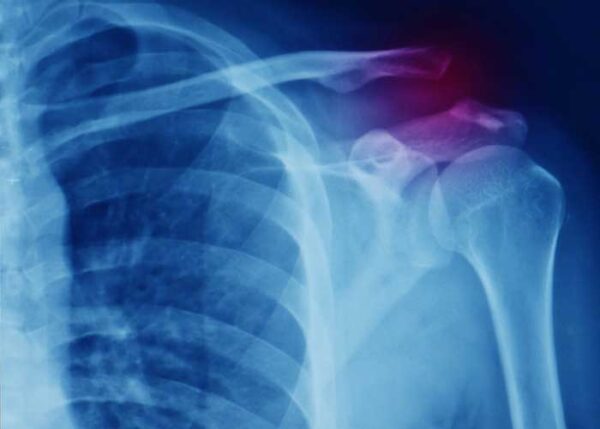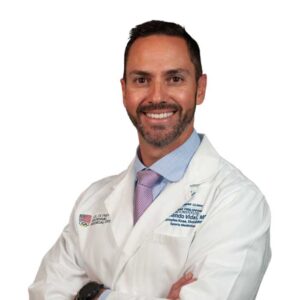What is an AC joint separation?
There are three joints that make up the shoulder; the glenohumeral joint, the acromioclavicular joint (AC joint) and the sternoclavicular joint. A shoulder separation is different from a dislocation. Dislocation refers to the main ball and socket joint (glenohumeral joint) Please place link to shoulder instability here. When a shoulder separation occurs, it refers to an injury to the acromioclavicular joint (AC joint) on the top of the shoulder. An AC joint separation occurs when the ligaments connecting the acromion and the clavicle at the AC joint are injured and the acromion moves away from the clavicle. Dr. Armando Vidal, orthopedic shoulder specialist serving Vail, Aspen and the surrounding Denver, Colorado communities, specializes in AC joint separation and can offer the best treatment options for his patients who are experiencing shoulder pain.

Who is at risk for an AC joint separation?
For young athletes, an AC joint separation is one of the most common causes of shoulder pain. Athletes that participate in high impact sports are most at risk for an AC joint separation and include sports such as hockey, wrestling and football. A traumatic fall, serious accident or any force that causes the collarbone and the roof of the shoulder to move away from each other, can pull or tear the ligaments holding the bones in their correct position.
What are the symptoms of acromioclavicular joint separation?
The symptoms of an AC joint separation can vary greatly depending on how severe the injury is. In general, the more severe the separation, the more intense the symptoms. Common symptoms include:
- Pain at the top of the shoulder
- Tenderness at the AC joint
- Swelling
- Shoulder deformity
- Limited range of motion
What are the types of AC separation?
Dr. Vidal measures AC joint separations depending on their severity:
- Type 1 – Commonly caused by a sprain or the stretching of the ligament, causing pain and discomfort. There is no deformity present and x-rays are normal.
- Type 2 – Partial separation of the AC joint. One of the ligaments, called the coracoclavicular (CC) ligament is intact, but the AC ligament is completely torn. Some deformity is present with these injuries and they are detectable on x-rays.
- Type 3 – Complete separation where both the AC ligament and the CC ligament are torn. Also, in most cases involves the joint capsule being torn. Deformity is typically very obvious in these cases.
- Types 4, 5 and 6 are very rare and include the rupture or tearing of the AC and CC ligament as well as the shoulder capsule, deltoid muscle and trapezius muscle. Injuries of this nature require reconstructive surgery.
How is an AC joint separation diagnosed?
If an AC separation is suspected, Dr. Vidal will perform a though exam of the shoulder, checking for weakness and areas of discomfort. With higher grade injuries, a physical deformity can sometimes be seen and can help determine the grade of separation. Often Dr. Vidal will request an x-ray to assess the severity, he will then develop the best treatment plan for his patients in Denver, Colorado area.
How is a shoulder separation treated?
Non-surgical Treatment:
Lower grade AC joint injuries can be treated with a non-surgical approach. A sling or brace can help immobilize the joint, ice, rest and medication, can help minimize pain and aid in healing. Patients are often able to return to their normal activities in 1-6 weeks. Pain, however, can persist for many months after an AC joint injury – even with the lower grade AC joint separations where the ligaments are only stretched and not completely torn.
Surgical Treatment:
Higher grade AC joint separations may require surgery. Dr. Vidal offers patients in the Vail, Aspen and surrounding Denver, Colorado communities a minimally invasive procedure called AC joint reconstruction. During this procedure, Dr. Vidal will use special surgical instruments to operate around the AC joint, reconstructing and repairing the torn ligaments and capsule. The AC joint is stabilized by repairing and tightening the damaged ligaments. In certain cases, the surgery may require a ligament graft to restore stability. Afterward, a specialized physical therapy program is required to regain strength and full motion of the AC joint.
Shoulder Joint Specialist
Are you an athlete participating in a high impact sport? If so, you may be at risk of experiencing an AC joint separation injury. AC joint separations occur when the collar bone and the shoulder joint move away from each other, possibly tearing or damaging ligaments. Shoulder specialist, Doctor Armando Vidal provides diagnosis as well as surgical and non-surgical treatments for patients in Vail, Aspen, and the surrounding Denver, Colorado communities who have experienced an AC joint separation injury. Contact Dr. Vidal’s team today!

Locations
180 S Frontage Rd W
Vail, CO 81657
226 Lusher Court
Ste 101
Frisco, CO 80443
322 Beard Creek Road
Edwards, CO 81632


